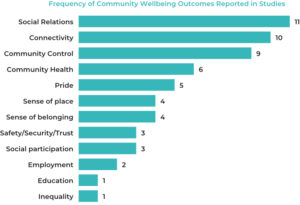Community agency and control – rapidly reviewing their impact on community wellbeing
Research suggests neighbourhood belonging, social connectedness and community control are determinants of health influenced by social conditions and that they can be addressed by local action.
Having reviewed the evidence for the first two determinants, we commissioned New Local to conduct a rapid review of the evidence for the third: community control and agency. The review was funded by the National Lottery Community Fund and the People’s Health Trust.
Our Community Wellbeing Lead, Stewart Martin, takes us through the key insights and outputs from the project.
Providing opportunities for people to have a say in what happens locally is important for community wellbeing, according to more than a third of UK respondents in recent National Lottery Community Fund community research.
This is more than felt similarly about bringing people together from across the community or supporting people to find new employment opportunities, and only marginally less popular than the idea that helping people to live healthily and well is important to community wellbeing.
Being able to exercise agency and control clearly matters to communities. Our review seeks to understand how community agency and control matters, through its impact on community wellbeing.
Key findings
Overall, the research indicates that improved community agency and control can lead to improved community wellbeing.
Specific insights include:
- Working towards a common aim resulted in improvements in community connection, trust, pride in and sense of place. These wellbeing outcomes improved regardless of whether the convening activity was formal or informal.
- Improvements for wellbeing outcomes were most apparent when communities could identify priorities, develop a vision and permit action together.
- Money is an effective facilitator, even when sums are relatively small. Funding helps communities develop confidence to bring about change and improve skills.
- In some situations, funding was also found to be a source of tension through power imbalances.
- 14 of 27 included studies documented negative or neutral impacts on community wellbeing outcomes.
- There was a wide range of intervention types across the included studies, making it more challenging to confidently identify what works.
For more detail, visit the briefing webpage or download the full report.
What we did
The review searched peer-reviewed and grey literature, and used a call for evidence, to find place-based evaluations that:
- had a community action or resident-led component or employed collective empowerment strategies to affect change at a local level
- targeted one or more community wellbeing outcomes
From an initial set of 5,500 studies, 225 were assessed for eligibility and 27 included in the final analysis. The figure below lists the community wellbeing outcomes and the frequency of their inclusion in those studies.

What next?
Based on the research insights, and broader considerations, recommendations were generated as guidance on how to put this evidence into action. These include:
- Understanding that communities have different starting points, and responding accordingly in the funding, design, implementation and evaluation of projects.
- Developing models to map contexts, mechanisms and outcomes that link community agency and community control to improvements in wellbeing. For example, a Theory of Change.
- Ensuring community-instigated projects are evaluated and added to the evidence base alongside externally-led studies.
- Recognising community agency and control’s value as a long-term endeavour.
To find out more, including why an intergenerational project felt it needed wider community support, the importance of relationship building in developing agency and control, or how ‘Neighbour Day’ protected participants against the mental health effects of lockdown, read the full report.
